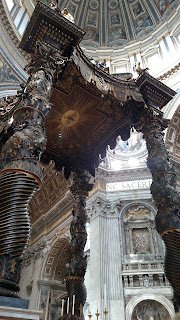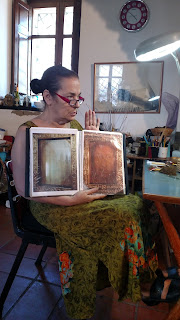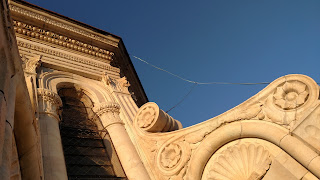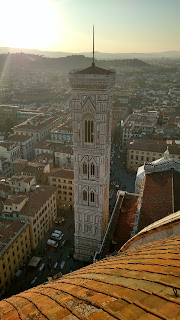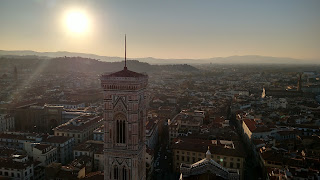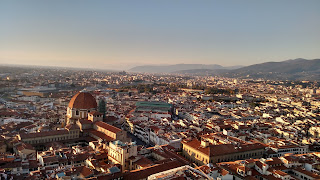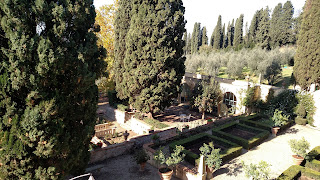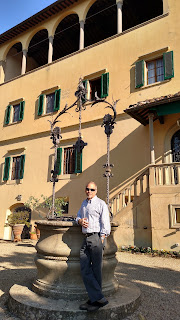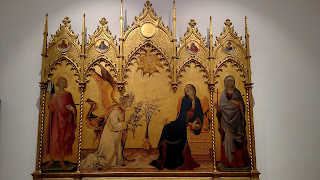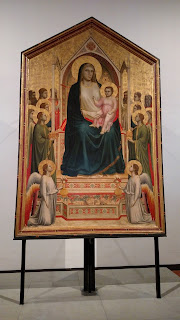- The Basilica centers around the Papal Altar where only the Pope celebrates Mass. It was consecrated by Clement VIII, June 5, 1594.
- A baldacchino is a processional altar.
- This baldacchino was designed by Bernini, commissioned by Pope Urban VIII & St. Peter's tomb is below the altar.
- Bernini's baldacchino is emblematic baroque design made of cast bronze and partially gilt.
- It took 9 years to build from 1624 to 1633.
- The entire project required more than 100,000 pounds of bronze, much of which was stripped from the Pantheon.
- The bronze "drapery" features the heraldic bees (symbol of chastity) of the Barberini family to whose family Pope Urban VIII belonged (he commissioned the baldacchino).
- Inside the "ciborium" is a dove, the symbol of the Holy Spirit, in a burst of golden rays, which complements the design of the Holy Spirit Window behind the baldacchino, above the altar.
- Above the frieze on each capital, four angels, (work of Francois du Duquesnoy) offer garlands.
- The vertex, where four ribs and palm branches converge, is crowned by the cross, set on a golden globe.
- The twisted columns are 20m tall and are presumably modeled after the eight columns of Solomon's temple, but the spiraling twists also suggest movement upward.
- The baldacchino is supported by 4 large (2.68m) marble pedestals . Each of the outer sides of the pedestals are decorated with Urban VIII's family coat of arms, the Barberini bees, and shields representing the stages of a woman in childbirth. It begins on the Southeast corner and moves clockwise, ending with a baby's face on the Northeast corner.
- The four columns are decorated with sprigs of olive, bay and cherubs (putti); acanthus leaves adorn the capitals.
- Eight putti carry the keys and the tiara of St. Peter, as well as the sword and book of St. Paul.
- The canopy was revealed to the public on St. Peter's day in 1633.
- The artist and those who commissioned the work were criticized because of the "cost no object budget" and enormous quantity of bronze used (103,229 lbs, taken from the Pantheon and other sites).
- To compensate for the loss of the Pantheon's treasures, two bell towers were built on either side of it which the public called the "donkey ears of Bernini." They were later demolished in 1883.
- The statement of the time was, "what the barbarians did not do, the Barberini's did."
Sacred Art & Fiber
This blog chronicles our journey to explore sacred art and fiber in Europe.
Wednesday, January 20, 2016
Friday, November 13, 2015
What Brought Me to Sant' Antioco?
Overview
Last summer (2015), I was perusing some technical articles on textile archaeology and I came across a reference to Byssus, a fiber also called "Sea Silk" spun from the collagen/keratin complex produced by the Pinna Nobilis, clam. I found it so intriguing, I began to google everything I could learn about this mysterious fiber with a history of sacred use for over 7,000 years.The Pinna Nobilis
What I learned was that Byssus was a sacred art fiber spun from a very particular type of clam, which is now an endangered species. This most revered, largest and "noble" species of clam is called the Pinna Nobilis and can grow up to 1 meter high, standing straight up on the ocean floor, like in the photo below. This bronzed clam sculpture reached just below my arm pit and was the actual clam.
7,000 Year History of Sacred Use
Byssus is exceedingly rare, requiring great dedication to produce a usable fiber. The arduous process required to refine it was probably one of the reasons it was reserved only for the most sacred applications. Presumably it was used as the first altar cloth, it was believed to be the material from which the Golden Fleece was made, it was used for robes of Pharaohs, Rabbis, Popes and kings, among other religious artifacts like the Veil of Veronica. It's primary captivating qualities are that when held in the sunlight, it gleams like gold and is completely weightless.
In art, Byssus is portrayed as a gossamer veil, as you can see from this piece by the Master of Femalle depicting the Veil of Veronica in 1430.
| "Sweat Cloth" Painted by the Master of Flémalle, ca. 1430 |
Her protegees told me that people from all over the world contact her to buy Byssus and to get her time, but they protect Chiara Vigo by responding on her behalf to keep the profiteers away. So I feel very privileged that she responded so immediately to my email, inviting me to be her guest. I made it very clear that I simply wanted to learn because I knew that money was never to be discussed or near this sacred fiber.
Maestro's Commendation from the Vatican
Absolutely Weightless
I've touched A LOT of fiber over the years. But never have I ever held 120 gm of fiber in my hand without knowing it.
The Maestro asked me to close my eyes as she placed 120 grams of cleaned and carded Byssus in my palm. I waited for the longest time to open my eyes because I never felt it touch my hand. I asked her to try the experiment again by turning my hand over, in the event that my palm was not sensitive enough, and sure enough, it was simply weightless and imperceptible; however, over the course of a few moments, I began to feel warmth, and that is the only way I knew I was holding it.
This bit of Byssus was "blonded" in her special secret formula of lemon juice, herbs and oil, so it appeared I was holding strands of gold, which felt like angel hair.
I took this photo from the internet because my eyes were closed during this process.
"Blonding" & Dyeing
Converting the brownish claim fiber into glistening gold involves processing in natural oils, herbs and lemon juice all accompanied by more than 40 different Aramaic prayers and songs. The only other colors used are the sacred colors of red and royal purple achieved with fruits and grapes.
The Lion
Chiara Vigo uses many symbols that have a folk art quality, but are actually based on ancient depictions, like this lion, which has Phoenician qualities. She brought this piece outdoors to show how the gold gleams in the sunlight, while looking a little coppery brown indoors. The Lion is her design embroidered in blonded Byssus on handmade, handwoven linen.
Chiara Vigo dives at a highly specific time of year (May-June) when the ocean reaches just a two degree temperature range and ocean salinity is just 4ppt, to harvest just the very top 2-5 cm of the Pinna Nobilis hair. In one season, this highly labor intensive process yielded about 300 gm of fiber after at least 100 dives, but after carding and cleaning, only 120 gm was usable. As a result, one of her masterpieces took five years to create.
| At 60 Years Old, the Maestro Still Dives to Harvest Byssus Herself |
 |
| Maestro Autographs My Book with the Peacock - Pre-Christian & Ancient Christian symbol of Eternal Life |
Wednesday, November 4, 2015
Views of Florence from the Top of the Brunelleschi Dome
At nearly 142 feet, the dome is larger than the domes of the Capitol Building in Washington, D.C., St. Paul's in London, the Pantheon in Rome, and even St. Peters in Vatican City. The dome remained the largest dome in the world until modern materials permitted the construction of stadium-sized domes such as the Metrodome in Minneapolis.
Construction began in 1296 and was completed in the late 14th century. The facade was completed in the 19th century. The dome is still the tallest building in Florence, after 600 years.
There is a section of the drum inside of the dome that was never finished. Here's why:
The decoration of the drum in the gallery, made by Baccio d'Agnolo, was never finished because Michelangelo was asked what he thought of it, and he famously replied that the decoration looked like a cricket's cage. Famous by that time, his opinion was taken quite seriously and worked was stopped to reconsider what to do. It was never completed and by this point, it is safe to assume it never will.
We climbed to the top of the dome, which enabled us to get a close up view of the Last Judgement painted on the ceiling of the dome.
Here are some of our photos:
Art Villa Agape
I'm going to plant a knot garden!
View from our room:
Jerry by the well.
Our room.
My Two Favorite Annunciations
There is a wide variety of symbols or standard elements that may be contained in an Annunciation which includes:
- Mary reading the Bible to demonstrate devotion
- Mary wearing a blue robe, a foreshadowing of royalty
- A pot or vase of lilies or other white flower signifying purity
- An empty vase means a pure vessel
- A straight line, visible or not, from Gabriel's mouth to Mary
- Gabriel looking like he just flew in to signify his quick flight from Heaven
- Mary appearing to be afraid, perhaps holding her palm up in the sign of piety
- Garden or scene in the garden to remind the viewer that her son takes away all sin
- The dove, or Holy Spirit
- The scallop sea shell to signify pilgrimage
- Mary & the angel are separated from the world
- A gilded background (pre mid-1400s)
The top piece is Italian Renaissance painter Leonardo da Vinci's from 1472-1475. This is considered to be one of Leonardo's early pieces and perhaps included some collaboration with other artists. But the departure from tradition is pure Leonardo. His soon-to-become other worldly trademark background will be used repeatedly in his work. He takes Mary outside, where she is casually reading in a garden, at an elaborately carved desk (a copy of his master's carved desk) and decides not to include the Holy Spirit as a dove or some of the other symbols of three. He was an independent thinker.
I love this piece for its soft, graceful facial expressions, reverence by the angel and the sheer elegance of color and simplicity of composition. Although this piece is not terribly large, it has an entire wall devoted to it at the Uffizi and seems to mesmerize the viewer.
Simone Martini's Annunciation (1333)
In contrast, my favorite traditional depiction is from the International Gothic style painter Simone Martini in his Annunciation from 1333. Simone Martini painted for the German and French courts, not reached by the influence of the Italian Renaissance for many years later. Remember, at this time in history, 150 years earlier than Leonardo, Italian artists were still developing their own style that was to symbolize the Renaissance. While very early in the Italian Renaissance, this Annunciation still has many of the Byzantine features, including the most stunning "Tatar" style cloth worn by Gabriel that swirls around his highly detailed feathered wings. Tatars were mongols in the Eastern Empire. His swirling cloth actually looks like a fine taffeta with a metallic gold thread.
Martini's Annunciation follows the rules better. Mary receives a message written from Gabriel's mouth directly along a straight line to her head that says "Hail, thou that art highly favored, the Lord is with thee, blessed art thou among women." What you cannot discern from a photograph is the relief. There is a technique in which red clay is placed on the painting and then the gilding is applied over the top that allows the viewer to see the written message in three dimension.
Gabriel holds the olive branch, or symbol of peace, while pointing to the Holy Spirit above. Mary has a star on her blue cloak, which is used in Eastern iconography to signify the "Star of the Sea" (again that sea reference) as the North Star is used by mariners to guide them.
I included a close up of St. Ansansus to show the gorgeous gold leaf halo which has a stamped look with beads and radiant lines.
I think the reason I like these two distinctly different pieces is because of their elegance and tenderness in expression.
Tuesday, November 3, 2015
The Maesta Genre
The three Maesta altarpieces I am posting here are the first I ever studied and are featured as the most grand and important in art history. The biggest impression is the sheer size of these pieces. This fact does not materialize when studying a blurry slide in art history class.
Altarpieces are intended to be seen from a great distance, high above the altar and this objective requires a monumental size. Cathedrals and basilicas were growing taller and taller during this time with an intention to reach God. So a high altarpiece was essential.
Duccio (1st Maesta) 1285, also known as the Ruccelai Madonna - the hallmarks of this Sienese painter's work is the Byzantine, two dimensional overall look, meaning thin, almond shaped eyes, long, thin faces, hands and that tell tale sineuous gold edging on the Madonna's blue robe. It is hard to tell from a photo, but his subjects seem to hang flat in space. There is no real perspective, no shading or size differentiation. But this is characteristic for 13th century art.
Giotto' (2nd Maesta) 1310 - Giotto is a monumental figure in art history because he is the first to begin employing techniques of perspective. His figures are very weighty and he mixes in white to create the beginnings of chiaroscuro (light-dark) painting for the purpose of creating contrast and perspective.
Cimabue (3rd Maesta) 1280-90 -Cimabue appears in the same breath, although perhaps less revered, as Duccio, also from the Sienese art school. One sees Byzantine features and lack of perspective common in the late 1200s. Cimabue is considered to be the bridge to the International Gothic style.
One thing they all have in common is the stunning gold leaf background which is intended to be Heaven.
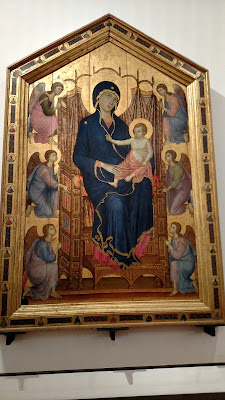 |
Monday, November 2, 2015
Ghiberti & Pisano Doors to the Baptistry
Built in about 1050, the Baptistry has eight sides and three doors--doors on the east, north, and south. The south doors, finished in 1330 by Andrea Pisano, have quatrefoils with eight seated Virtues and 20 scenes from the life of John the Baptist. (The baptistry is dedicated to him.)
Ghiberti, a jewelry maker, won the contest to create the north doors, designed in 1404-24, using the same quatrefoil format as Pisano. His second set of doors--the Gates of Paradise, have much larger panels and use a square format rather than the medieval quatrefoil.
The larger doors depict scenes from the Old Testament from the Creation to the reign of Solomon.
As a jewelry maker, he was expert in lost wax technique, which he utilized to make these doors. Ghiberti is almost painting in sculpture through 1point perspective creating receding figures. This technique called relievo schiacciato, is best demonstrated in Donatello's relief "The Feast of Herod" on the baptismal font in the Siena Baptistry (1427). This painting in sculpture technique created psychological realism in sculpture through cause & effect scenes.
Although Ghiberti uses the medieval narrative method of combining several stories within one frame, the reliefs show the influence of classical sculpture in the figure style and poses of some of the characters, the influence of classical architecture in the buildings portrayed, and the influence of Renaissance realism in the gestures and movements of his figures.
Friday, October 30, 2015
The Holy Spirit Window
The term "Oculus" simply means eye in Latin and refers to round or oval shaped windows that appear as early as the Roman Empire. Most often ocula were ceiling windows, or God's eye seeing into the church watching over everyone, or typically over a mausoleum, although they could technically be any rounded window.
While there is so much in St. Peter's that could be considered the piece of crowning glory, the famed Holy Spirit Window over the main altar in the apse is most definitely the one.
The window itself is constructed of 12 sections representing the 12 apostles, of sliced and pieced alabaster, a translucent stone, through which the sun illuminates the dove, or Holy Spirit, in the window's center panel. When we were in the basilica mid afternoon, the sun shone through the stone oculus and cast a warm glow over the altar.
The gold bars burst forth from the Holy Spirit, surrounded by angels, directly above the altar and bronze chair which is the unmistakable work of Gian Lorenzo Bernini, 1598-1659, and is said to contain pieces of the original oak chair St. Peter sat in to preach the gospel. There are three medallions in which these three scenes are depicted: the transfer of the keys to Peter, the crucifixion of Peter and the beheading of Paul.
The altar is a deep, blood red jasper stone quarried from Sicily. The base of the altar is black and white marble from Aquitaine, flanked by four very large gilded bronze figures (5 meters). The two outside figures are St. Ambrose and St. Augustine of the Latin church. The two inner bare headed figures are from the Greek church. The chair appears to float over these figures, symbolizing that the gospel is not wholy supported by man, but emanates from the Word.
There is a circular inset of the same red jasper stone on which Charlemagne was crowned Holy Roman Emperor that was part of the original church. Anyone treading upon that disk would have been executed. This piece was removed and replaced near the front doors in the 16th century basilica.
I was the last person allowed to photograph the altar as they were preparing for mass.
Raphael's "Transfiguration"
This was the high renaissance painter, Raphael's own favorite painting. It is said to have been brought to his deathbed at his request so that he could gaze upon it with his last breath.
The Transfiguration was completed in 1520, right before Raphael's death.
Like Raphael's treatment of "The Deposition" in which he combined the "Descent from the Cross" with "The Entombment," he also combines two subject matters in this painting, featuring "The Transfiguration of Christ" to the deciples on Mt. Tabor above with the story of the apostles' failure to cure a possessed boy until the transfigured Christ intervenes, below.
According to Goethe: "The two are one: below suffering, need, above, effective power, succour. Each bearing on the other, both interacting with one another."
The woman in the light pink and blue is painted once again by Raphael in the figura serpentina pose, extreme contraposto or "S" shape that acts as a link between subject matter. She also appears in The Deposition. In the same year, Michelangelo used this same figure, in the same pose in the Doni Tondo. I've referenced the latter two in a previous post.
St. Veronica Holding the Veil
According to the Bible, St. Veronica was the woman who wiped Christ's brow after he fell during his passion. His image is said to have been permanently imprinted on her veil. The veil of Veronica is believed to be a relic here at St. Peter's and this is the image by which to identify St. Veronica in art.
The sculptor, Bernini, was the master of creating fluidity and movement out of stone replicating the folds and draping of fabric. As you can see from this sculpture, St. Veronica's robes and veil appear to be blowing wildly in the wind. In art, the Holy Spirit is portrayed in as the wind, or puff or breath of air. So the combination of subject matter and presentation was a way to convey her sainthood to the masses.
As everything else in St. Peter's, it is impressively large at probably over 14 feet tall.
Thursday, October 29, 2015
Michelangelo's Pieta
One can't help but be overwhelmed by the perfection of Michelangelo's Pieta, marble as fluid as fabric, as realistic as flesh and as expressive as heartfelt sorrow.
Jesus appears to slip from her lap as though onto the surface before you, intentionally. The Pieta was intended to be an altar piece, so the symbolism of slipping into the altar is a direct reference to the Eucharist.
Michelangelo used the same expression on the Pieta Mary as he had in the Annunciation Mary, which is to say yes, or to be resigned to God's will.
The Pieta is now out of the public's reach behind glass after an incident many years ago when a derranged person knocked off her left hand with a hammer. I recall this from my childhood.
St. Peter's Overwhelm
We know Michelangelo for painting the Sistine Chapel ceiling, but until that time, he had been best known as a sculptor. The Sistine Chapel required the ceiling to be painted to cover an unsightly seam from a patch necessitated when part of the structure sank, as St. Peter's was built on a swamp.




